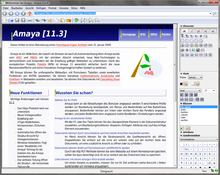
An online rich-text editor is the interface for editing rich text within web browsers, which presents the user with a "what-you-see-is-what-you-get" (WYSIWYG) editing area. The aim is to reduce the effort for users trying to express their formatting directly as valid HTML markup.
Though very early browsers could display rich text, user data entry was limited to text boxes with a single font and style (implemented with the <textarea> HTML element). Internet Explorer was the first to add a special "designMode" which allowed formatted parts of a document to be edited by the user using a cursor. Mozilla followed suit in version 1.3,[1] and most major browsers now implement this informal standard in some capacity.[2]
The technical capabilities needed to implement an online rich text editor were not covered by the W3C specifications for HTML4. Nevertheless, popular services like Gmail and WordPress have relied on rich text editing as their main user interface. With HTML5, some standardization was made on a DOM property called "contentEditable"—which resembles Internet Explorer's original extension.[3] Many of the online office suites tend to provide online text editing and formatting functionality.
- ^ "Rich-Text Editing in Mozilla". developer.mozilla.org.
- ^ "RE: HTML Action Item 54 - ...draft text for HTML 5 spec to require producers/authors to include @alt on img elements. from Frederico Caldeira Knabben on 2008-05-14 (public-html@w3.org from May 2008)". Lists.w3.org. Retrieved 2010-09-23.
- ^ "7 User interaction — HTML5". W3C. Retrieved 2010-09-23.
